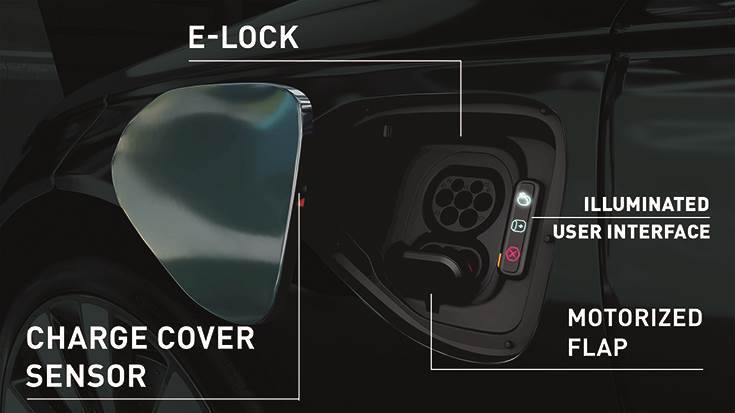Robotic charging solutions are set to enable the fully automated charging of vehicles using robotic arms in the future. The prerequisite for a smooth process flow are globally valid norms and standards. German supplier Marquardt is contributing to the foundations for this as part of the ROCIN-ECO research project.
Under the leadership of Ionity, Audi and TUV SUD, the mechatronics specialist is developing a standardized automated fast charging solution together with the charging robot manufacturer Rocsys. Other associated project partners are BMW, Porsche, Ford, Huber+Suhner and AVL. The consortium will contribute the results to the relevant standardisation bodies, such as ISO, IEC and CCC.
On June 18, robotic charging will also be shown in practice in a live demonstration at the Ionity test site in Unterschleisheim. For this purpose, an Audi E-Tron and a charging robot from Rocsys were equipped with Marquardt’s communication and localization solution based on Ultra-Wideband (UWB) and Bluetooth Low Energy (BLE).
 Marquardt charging system portfolio with the components E-Lock, Charge Cover Sensor, Motorized Flap and Illuminated User Interface (IUI).
Marquardt charging system portfolio with the components E-Lock, Charge Cover Sensor, Motorized Flap and Illuminated User Interface (IUI).
Numerous fields of application
The trend towards e-mobility and autonomous driving opens up numerous fields of application for robotic charging, even beyond the automotive sector. “In addition to autonomous valet parking and charging, where vehicles park and charge completely independently, we see potential wherever mass charging is in demand for fleet operators, for example in the truck or material handling sector and in port intralogistics,” explains Andreas Becher, Technical Project Manager Innovation at Marquardt. “Globally valid norms and standards are essential for practical implementation, and we are now creating the foundations for this.”
Marquardt components are robotic charging ready
With the Interactive Charging System (ICS) and the extended Smart Access System PnD3, Marquardt will soon be offering vehicle and charging robot manufacturers around the world central components that enable robotic charging. The ICS with the integrated locking module E-Lock from Marquardt can be combined with the various global inlet standards (CCS, NACS, ChaoJi, CHAdeMO, GB/T).
 The Marquardt solutions for charging electric vehicles (from left): E-Lock, Illuminated User Interface, Motorized Flap, Smart Access ECU, Digital Key Module / UWB/BLE Node.
The Marquardt solutions for charging electric vehicles (from left): E-Lock, Illuminated User Interface, Motorized Flap, Smart Access ECU, Digital Key Module / UWB/BLE Node.
In addition, the ICS is currently the only charging system to offer the option of an automated charging flap and motorized inlet port cover – one of the basic requirements for future automated charging. With the keyless Smart Access System PnD3, Marquardt also has the basis for digital key sharing in exchange with the robot charging station.
Globally scalable solution
As a member of the Car Connectivity Consortium (CCC), Marquardt states that it “attaches great importance to using the already standardized CCC-compliant localisation and communication between vehicle and charging robot as the basis for robotic charging. This ensures the continued use of vehicle components that have already been introduced internationally. In addition, when submitting proposals to the standardization committees, care was taken to ensure that the process for automated charging is applicable to all existing standards worldwide.
Communication between the charging robot and vehicle takes place via the interaction between CCC-compliant ultra-wideband (UWB) technology for correct positioning of the vehicle in front of the charging station, Bluetooth Low Energy (BLE) for communication between the vehicle and charging robot and cloud-based digital key sharing. In order for the vehicle to open its charging flap and inlet port cover and release them for charging, the charging robot requires the digital vehicle key. This is transmitted via a backend cloud solution from Marquardt. Thanks to secure communication between the vehicle and the charging robot, a smooth overall process flow is ensured.
Robotic Charging Components Live at the Battery Show
“Together with our partners, we want to drive forward the possibilities of robotic charging. In our contribution, we have evaluated system requirements that can be transferred into norms and standards in the next step,” explains Stefan Ruf, Product Manager Innovation at Marquardt. “Possible applications such as autonomous valet parking and charging services would then be possible in just a few years. The goal now must be to bring everyone involved together – from car manufacturers to parking and charging point operators – in order to advance the application together.”
From June 18 – 20, 2024, Marquardt will be presenting key components of Robotic Charging live at the Battery Show Europe in Stuttgart. These include a fully automated demonstrator of the Interactive Charging System (ICS) and a 3D video animation of the complete robotic charging process, which can be seen at the following link: https://www.marquardt.com/roboticcharging
